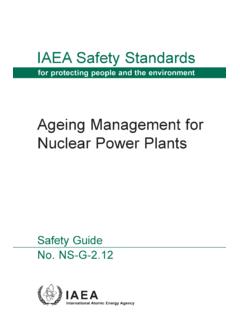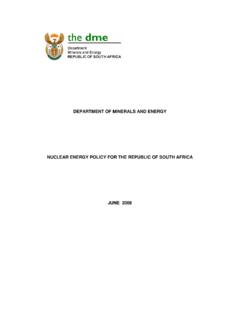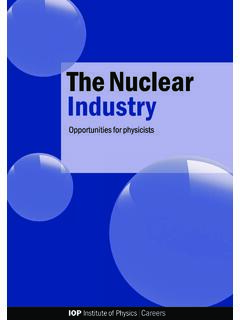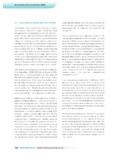Transcription of COBALT-60 PRODUCTION IN CANDU POWER …
1 COBALT-60 PRODUCTION IN CANDU POWER REACTORS Malkoske MDS Nordion 447 March Road Kanata, Ontario, K2K 1X8, Canada 613-592-2790 J. Slack Norton Atomic Energy of Canada Limited MDS Nordion 2251 Speakman Drive 447 March Road Mississauga, Ontario, L5K 1B2, Canada Kanata, Ontario, K2K 1X8, Canada 905-823-9060 613-592-2790 ABSTRACT key words: cobalt , reactor, CANDU MDS Nordion has been supplying COBALT-60 sources to industry for industrial and medical purposes since 1946. These COBALT-60 sources are used in many market and product segments, but are primarily used to sterilize single-use medical products including; surgical kits, gloves, gowns, drapes, and cotton swabs. Other applications include sanitization of cosmetics, microbial reduction of pharmaceutical raw materials, and food irradiation.
2 The technology for producing the COBALT-60 isotope was developed by MDS Nordion and Atomic Energy of Canada Limited (AECL) almost 55 years ago using research reactors at the AECL Chalk River Laboratories. In order to produce COBALT-60 in CANDU POWER reactors, the stainless steel adjusters are replaced with neutronically equivalent cobalt -59 adjusters. With its very high neutron flux and optimized fuel burn-up, the CANDU has a very high COBALT-60 PRODUCTION rate in a relatively short time. Many design considerations and requirements for the PRODUCTION of COBALT-60 in CANDU must be assessed, such as; operator and public safety, minimum impact on station efficiency and reactor operations, shielding requirements during reactor operation with COBALT-60 adjusters and removal of the COBALT-60 adjusters from core, transportation within the station, and finally the processing and shipment off-site. This Canadian technology for COBALT-60 PRODUCTION in CANDU reactors, designed and developed by MDS Nordion and AECL, has been safety, economically and successfully employed in many CANDU reactors with over 195 reactor years of PRODUCTION .
3 This paper will describe, at an overview level, the MDS Nordion proprietary technology and know how that is used to provide CANDU reactors with a safe and economical capability to produce COBALT-60 . CANDU (CANada Deuterium Uranium) is a registered trademark of Atomic Energy of Canada Limited (AECL). 1. BACKGROUND MDS Nordion has been supplying COBALT-60 sources to industry for industrial and medical purposes since 1946. These COBALT-60 sources are used in many market and product segments. The major application is in the health care industry where irradiators are used to sterilize single use medical products. These irradiators are designed and built by MDS Nordion and are used by manufacturers of surgical kits, gloves, gowns, drapes and other medical products. The irradiator is a large shielded room with a storage pool for the COBALT-60 sources. The medical products are circulated through the shielded room and exposed to the COBALT-60 sources. This treatment sterilizes the medical products which can then be shipped to hospitals for immediate use.
4 Other applications for this irradiation technology include sanitization of cosmetics, microbial reduction of pharmaceutical raw materials and food irradiation. 2 The COBALT-60 sources are manufactured by MDS Nordion in their cobalt Operations Facility in Kanata. More than 75,000 COBALT-60 sources for use in irradiators have been manufactured by MDS Nordion. The COBALT-60 sources are double encapsulated in stainless steel capsules, seal welded and helium leak tested. Each source may contain up to 14,000 curies. These sources are shipped to over 170 industrial irradiators around the world. This paper will focus on the MDS Nordion proprietary technology used to produce the COBALT-60 isotope in CANDU reactors. Almost 55 years ago MDS Nordion and Atomic Energy of Canada developed the process for manufacturing COBALT-60 at the Chalk River Labs, in Ontario, Canada. A cobalt -59 target was introduced into a research reactor where the cobalt -59 atom absorbed one neutron to become COBALT-60 .
5 Once the COBALT-60 material was removed from the research reactor it was encapsulated in stainless steel and seal welded using a Tungsten Inert Gas weld. The first COBALT-60 sources manufactured using material from the Chalk River Labs were used in cancer therapy machines. Today the majority of the cancer therapy COBALT-60 sources used in the world are manufactured using material from the NRU reactor in Chalk River. The same technology that was used for producing COBALT-60 in a research reactor was then adapted and transferred for use in a CANDU POWER reactor. In the early 1970s, in co-operation with Ontario POWER Generation (formerly Ontario Hydro), bulk COBALT-60 PRODUCTION was initiated in the four Pickering A CANDU reactors located east of Toronto. This was the first full scale PRODUCTION of millions of curies of COBALT-60 per year. As the demand and acceptance of sterilization of medical products grew, MDS Nordion expanded its bulk supply by installing the proprietary Canadian technology in additional CANDUs.
6 Over the years MDS Nordion has partnered with CANDU reactor owners to produce COBALT-60 at various sites. CANDU reactors that have, or are still producing COBALT-60 , include Pickering A, Pickering B, Gentilly 2, Embalse in Argentina, and Bruce B. AECL s CANDU Reactor AECL s CANDU Reactor is unique among the POWER reactors of the world, being heavy water moderated and fuelled with natural uranium. They are also designed and supplied with stainless steel adjusters as part of the reactor regulating system, which is to shape the neutron flux to optimize reactor POWER and fuel burn-up, and to provide excess reactivity needed to overcome xenon-135 poisoning following a reduction of POWER . The reactor is designed to develop full POWER output with all of the adjuster elements in the core. For COBALT-60 PRODUCTION , the reactor s full complement of stainless steel adjusters is replaced with neutronically equivalent cobalt -59 adjusters, which are essentially invisible to reactor operation.
7 With its very high neutron flux and optimized fuel burn-up, the CANDU has a very high COBALT-60 PRODUCTION rate in a relatively short time. This makes CANDU an excellent vehicle for bulk COBALT-60 PRODUCTION . Prior to a utility engaging in COBALT-60 PRODUCTION , and notwithstanding the obvious initial change in licensing requirements and submissions, there are many engineering design considerations and requirements for the PRODUCTION of COBALT-60 in CANDU which must be assessed. These include operator and public safety, minimum impact on station efficiency and reactor operations, shielding requirements during reactor operation with COBALT-60 adjusters, removal of the COBALT-60 adjusters from core, transportation within the station, and finally the processing and shipment off-site. Execution of the above mentioned results in the design and supply of the specialized equipment required for the PRODUCTION and handling of cobalt Adjuster Rods. CANDU Reactors currently produce many millions of curies per year of COBALT-60 for MDS Nordion s use in industry and commerce.
8 Following the removal and replacement of stainless steel adjusters with cobalt adjusters, the cobalt adjusters are removed from the reactor at approximately 2 year irradiation intervals, and transported to the remote Secondary Irradiated Fuel Bay (SIFB) for storage and processing. In the SIFB the cobalt adjusters are disassembled and the individual cobalt bundles prepared for offsite shipment to MDS Nordion in their purpose built and licensed transportation flasks. In compliance with the above and to facilitate cobalt PRODUCTION , the cobalt Adjuster Element 3 Processing System (CAEPS) was designed to permit the replacement of all of the cobalt adjuster rods during routine reactor maintenance shutdowns. The cobalt removal and transfer equipment was designed to be used intensively for relatively short periods of time and to function quickly and reliably so that the limited time window available for the replacement process would not be missed. The cobalt removal and transfer system is mechanized extensively in order to minimize labour and operator skills required.
9 The system is designed for high productivity, to minimize the demands upon the station maintenance staff during the critical maintenance interval, and to increase the profitability of the operation. cobalt Adjusters As previously stated a set of cobalt adjuster rods are provided in the reactor as part of the Reactor Regulating System (RRS). Initially, the design provided for D2O cooling of the adjuster to address perceived thermal requirements. However, D2O cooling has since been demonstrated as unnecessary and the system valved out. The requirements for flux flattening in the core result in a number of different types of adjuster rods. Each cobalt adjuster rod assembly consists of a number of bundles, each bundle containing up to 6 cobalt pencils. The adjuster rods are assembled from standard design components. Only the centre rod and stainless steel cable lengths are special for each adjuster application, as determined by the number of bundles required due to its location in the reactor.
10 The cobalt bundle assembly is the basic building block of an adjuster rod. It consists of two circular end-plates held apart by two welded support tubes. The plates feature an outer ring of holes, which are precisely aligned so that one to six pencils can be inserted into them as required. Once inserted, the pencils are held in position by a snap ring, secured by a groove in the upper end plate and a shoulder on the bottom end plate. The pencils are seal-welded zircaloy tubes filled with cobalt slugs. They are standardized components, made to suit service conditions as well as reactor requirements. The cobalt in the pencils constitutes the bulk of neutron absorbing material, the rest of the adjuster assembly being built mostly of zircaloy and designed for the smallest practical neutron absorption. The pencil and bundle lengths are matched so that the pencils, acting in compression, add to the bending structural stiffness of the bundle assembly. The cobalt bundles, loaded with pencils as required, are threaded onto the center rod in a sequence to match the negative reactivity requirements for each adjuster type, due to its particular location in the reactor core.




